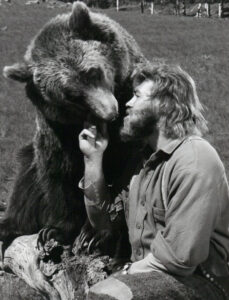By Sharon Oliver
Contributing Writer
MEDWAY – Many can recall the 1970s classic television series “The Life and Times of Grizzly Adams.” Fans tuned in each week to see the innocent fugitive and bear whisperer, played by Dan Haggerty, help strangers navigate through the wilderness. Of course, some of those strangers had ulterior motives. Nevertheless, the story of the real Grizzly Adams did not begin as a man falsely accused of murder, on the run with no one but a trader named Mad Jack (Denver Pyle), Nakoma (Don Shanks), and a bear named Ben for friends.

Photo/Wikimedia Commons
Medway shoemaker
California’s legendary mountain man John Boyden Adams (or John Capen Adams) was born in Medway to Eleazar and Sybil Adams in 1812. In actuality, his first job was that of a shoemaker in Massachusetts and he only lived in the California mountains for less than five years. According to his biography, Adams did show an interest in and talent for managing a troupe of animals brought to the U.S. from Africa. Such boldness can come with a price. He found himself bedridden for months after a near-deadly encounter with a Royal Bengal tiger. After spending a year in recovery, Adams resumed his cobbling business.
Adams married a woman named Cylena Drury and the couple had two daughters. Tragedy struck in 1849 when Adams and his father Eleazar lost their combined savings in a fire that destroyed their business. Unable to cope with the financial hardship, Eleazar Adams hung himself that same year. Despondent, Grizzly headed west to join other California Gold Rush chasers with a promise to send money back to his family whenever he could.
Into the mountains
While in California, Adams mined for gold and worked on farms and ranches. He also invested in real estate ventures and was soon able to earn enough money to start his own sluice business, employing several men. After getting conned by business partners, the 40-year-old Adams packed his belongings into an ox cart and hiked the 200-mile trail into the Sierra Nevada where his bearded frontier man persona took shape. He ate nuts and berries and wore various animal furs.
Adams reportedly formed a close relationship with Native American tribes in the area, unlike other down-on-their-luck- gold miners turned mountain men who found the five-dollar offer for a Native American’s scalp much more lucrative.
Grizzly Adams chose to track and tame wild animals, sometimes with the aid of indigenous men. He advertised himself as an expert trapper and tamer and showcased his catch as a traveling menagerie. Unlike the television series, the real story of how he trapped and trained his animals is far different. Historian Jon T. Coleman wrote: “Lions escaped and ate Shetland ponies. Grandstands and tents collapsed, pinning women and children in the crush; caravans dropped through bridges, wrecking wagons and drowning specimens.”
Furthermore, it was alleged that Adams regularly beat the bears to keep them in submission and that he obtained his famous bear, Ben Franklin, by killing its mother, and then forcing a greyhound to suckle the cub. Undoubtedly, it is much easier to sell the story of a man who lived harmoniously amongst wild beasts than to tell the tale of an animal abuser.
Grizzly Adams eventually sold what was left of his menagerie to P. T. Barnum and moved back to Boston to be with his wife and one of their daughters. He died in 1860 at the age of 48 from complications of a serious head injury sustained during a wrestling match with one of his bears in 1858. P. T. Barnum paid for his funeral and burial in Charlton. Interestingly, California’s state flag, painted by Charles Nahl in 1855, features a grizzly bear named Samson. The bear was once captured and owned by John “Grizzly” Adams.
RELATED CONTENT:
Unusual museums make for some offbeat outings
The road ended where it began for ‘The father of the Beats’
Crispus Attucks of Framingham became an icon of the American Revolution












